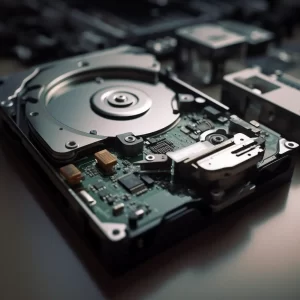Considering the significance of thermal paste in heat management and its common usage on other heat-producing components, it raises the question of whether applying thermal paste on the HDD can provide similar benefits. Is it a practical solution to address potential heat-related concerns specific to the HDD?
Comparison of heat generation of HDD compared to CPU and GPU

When compared to heat-producing components like the CPU and GPU, HDDs generally generate less heat. The primary reason for this is the difference in their operational mechanisms. HDDs rely on magnetic storage technology and rotating platters to read and write data, which results in relatively lower heat generation compared to the intensive computational processes of CPUs and GPUs. Furthermore, HDDs are designed with built-in heat dissipation mechanisms, such as metal casings or heat sinks, which effectively dissipate the generated heat.
Can heat destroy HDD?
Yes, excessive heat can indeed damage a hard disk drive (HDD). Every component in a computer, including HDDs, has a specific operating temperature range, which if exceeded, can lead to component failure. For hard drives, the ideal operating temperature is typically between 30 and 40 degrees Celsius (86 to 104 degrees Fahrenheit).
When a hard drive is exposed to excessive heat for a prolonged period, it can cause various problems:
- Physical damage to components: The physical components of the hard drive, like the read/write head and the platters, can warp or expand, leading to mechanical failures.
- Data loss or corruption: Heat can also affect the magnetic properties of the hard drive, which stores your data. This can lead to data corruption or even data loss.
- Reduced lifespan: While not immediately destructive, prolonged exposure to high temperatures can shorten the lifespan of a hard drive.
Can I put thermal paste on an HDD?
When considering the application of thermal paste on HDDs, The potential risks and damages that may arise.
- Sensitivity of HDD Components: HDDs consist of delicate components, including intricate circuits and moving parts. Applying thermal paste directly onto the HDD can pose additional risks. Excessive amounts of thermal paste or improper application techniques may lead to the paste seeping into the internal components of the HDD. This can potentially damage sensitive parts, affect performance, or even render the HDD inoperable.
- Manufacturer Recommendations: HDD manufacturers typically do not recommend applying thermal paste on their hard drives. They have designed HDDs with their own thermal requirements and have taken into account the necessary cooling mechanisms. Modifying the original design by adding thermal paste may void the warranty or introduce unforeseen issues.
Potential Impacts of Excessive or Improper Application
Potential Issues | Description |
Paste Leakage | Excess thermal paste may seep into the HDD, potentially damaging internal components and affecting performance. |
Performance Impact | Improper application can hinder heat dissipation, leading to increased HDD temperatures and potential performance degradation. |
Warranty Void | Applying thermal paste may violate the HDD manufacturer’s warranty terms, rendering any future claims invalid. |
System Inoperability | Severe damage caused by incorrect application may render the HDD non-functional, requiring replacement. |
It is crucial to consider the recommendations and guidelines provided by HDD manufacturers regarding the use of thermal paste. These guidelines are established based on extensive testing and analysis to ensure the proper functioning and longevity of the HDD. Therefore, it is generally advised to adhere to the manufacturer’s recommendations and avoid applying thermal paste directly on HDDs.
Proper Airflow and Cooling
Proper airflow and cooling are essential for optimal computer performance and the longevity of components like HDDs. Adequate airflow helps dissipate heat, preventing excessive temperatures that can harm performance and reliability. This can be achieved through well-ventilated computer cases with openings for air inflow and outflow.
Additionally, Placed case fans assist in promoting airflow and efficient heat dissipation. To maintain proper system operating temperature, it is important to organize cables to allow unobstructed airflow and regularly clean the computer system to remove dust buildup.
Consideration of Alternative Cooling Solutions
Consider alternative cooling solutions, such as SSDs and external cooling options, to address heat-related issues and improve system performance.
- SSDs generate less heat compared to HDDs, mitigating performance issues caused by excessive heat.
- Verify compatibility and installation options for SSDs in your computer system.
- SSDs offer advantages like faster data access and lower power consumption.
- For additional cooling, explore options like cooling pads, liquid cooling systems, or dedicated hard drive coolers.
Frequently Asked Questions
Can I put thermal paste on an SSD?
While the idea of applying thermal paste to an SSD may seem like a good way to enhance its thermal efficiency, it’s typically unnecessary. SSDs, unlike CPUs or GPUs, do not generate significant heat requiring thermal paste for dissipation. It’s more crucial to ensure a good airflow in your computer case to maintain optimal SSD temperature.
Can I put thermal paste on an M.2?
Direct application of thermal paste on an M.2 drive isn’t standard practice. These drives often come with a thermal pad, an alternative solution that conducts heat away from the M.2 drive and helps avoid overheating. It’s advised to use the provided thermal pad or similar heat-conducting solutions rather than applying thermal paste directly.

